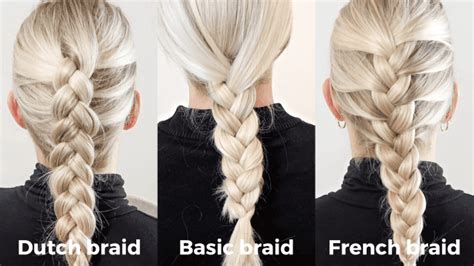Introduction
When it comes to braiding, the two most popular and time-honored techniques are Dutch braiding and French braiding. Each style offers distinct characteristics and versatility, providing countless possibilities for both casual and formal occasions. This comprehensive guide will delve into the intricacies of both methods, exploring their similarities, differences, and practical applications.

The Dutch Braid
Origins and Execution
The Dutch braid, also known as the inverted French braid, originated in the Netherlands. It involves starting with three strands of hair and crossing the side strands under the middle strand, creating a raised and voluminous effect. This technique requires a bit more dexterity than the French braid but yields a visually striking and intricate result.
Advantages and Disadvantages
Advantages:
- Adds height and volume to the hair
- Ideal for long and thick hair
- Creates a secure hold, making it suitable for active lifestyles
Disadvantages:
- More time-consuming than the French braid
- Can be less comfortable for some due to the tension created
- May appear bulkier on fine hair
The French Braid
Origins and Execution
The French braid, a timeless hairstyle with roots in France, is characterized by crossing the side strands over the middle strand. It creates a smooth, elegant, and secure braid that is often used for both everyday and special occasions. The French braid is a relatively simple technique that can be mastered with practice.
Advantages and Disadvantages
Advantages:
- Effortless to create
- Suitable for all hair types
- Provides a polished and versatile look
Disadvantages:
- Less voluminous than the Dutch braid
- Can become loose over time
- May require more frequent touch-ups
Comparison of Key Features
| Feature | Dutch Braid | French Braid |
|---|---|---|
| Origin | Netherlands | France |
| Strand Crossing | Side strands under middle strand | Side strands over middle strand |
| Appearance | Voluminous, raised | Smooth, elegant |
| Hold | Secure | Moderate |
| Hair Type | Long and thick | All hair types |
| Technique Difficulty | Moderate | Easy |
| Time Required | More | Less |
Practical Applications
Both Dutch and French braids have a wide range of applications, catering to various occasions and hair types.
Dutch Braid:
- Formal Updos: Create intricate and voluminous buns, chignons, and half-up hairstyles.
- Active Hairstyles: Secure hair away from the face for workouts, sports, and outdoor activities.
- Boho Chic: Enhance bohemian styles with loose, messy Dutch braids.
French Braid:
- Everyday Hair: Add a touch of elegance to everyday looks.
- Bridal Hairstyles: Create stunning updos and half-ups for weddings and special events.
- Protective Styles: Braid hair to reduce damage from heat, styling, and environmental factors.
Common Mistakes to Avoid
- Overtightening: Braiding too tightly can cause discomfort and damage hair.
- Uneven Strands: Ensure strands are roughly equal in thickness to create a balanced braid.
- Loose Ends: Secure loose ends with hairpins or bobby pins to prevent the braid from unraveling.
- Unbalanced Crossing: Cross strands consistently to maintain a neat and even braid.
Testimonials
“The Dutch braid has been my go-to hairstyle for years. It gives me instant height and volume, and it holds all day long.” – Sarah, a stylist from New York.
“I love the French braid for its versatility. It’s perfect for both casual and formal occasions, and it always gives me a polished look.” – Emily, a student from Los Angeles.
Conclusion
Whether you prefer the voluminous and eye-catching Dutch braid or the classic elegance of the French braid, there is a braiding technique for every occasion and hair type. By understanding the intricacies of each style, you can master the art of braiding and create beautiful, functional, and stylish hairstyles that will turn heads wherever you go.
